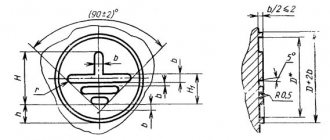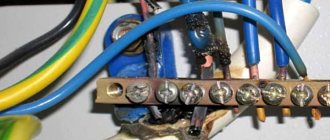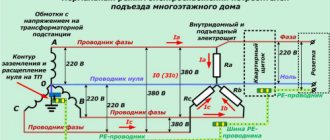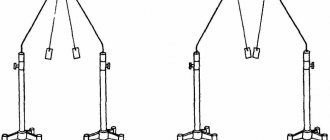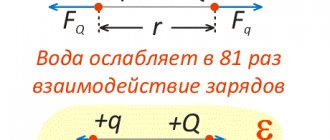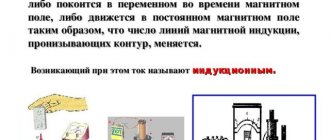Conductors of the first and second kind.
Conductors are substances that conduct electric current due to the presence of a large number of charges in them that can move freely (unlike insulators).
They are of I (first) and II (second) kind. The electrical conductivity of type I conductors is not accompanied by chemical processes; it is caused by electrons. Type I conductors include: pure metals, i.e. metals without impurities, alloys, some salts, oxides and a number of organic substances. On electrodes made of type I conductors, the process of transfer of a metal cation into a solution or from a solution to the metal surface occurs. Type II conductors include electrolytes. The passage of current in them is associated with chemical processes and is caused by the movement of positive and negative ions. After substituting the numerical values of E 0 and b 0 at 25 o C:
Calomel electrodes are mercury coated with calomel paste and mercury in contact with a KCl solution.
The electrode reaction is reduced to the reduction of calomel to metallic mercury and chlorine anion:
The potential of the calomel electrode is reversible with respect to chlorine ions and is determined by their activity:
At 25 o C, the potential of the calomel electrode is found using the equation:
Mercury sulfate electrodes SO4 2 – /Hg2SO4, Hg are similar to calomel electrodes with the only difference that the mercury here is covered with a layer of paste from Hg and mercuric sulfate, and H2SO4 is used as a solution. The potential of a mercury sulfate electrode at 25 o C is expressed by the equation:
The silver chloride electrode is a system Сl – /АgСl, Аg, and its potential corresponds to the equation:
ECl – /АgСl, Аg = Е 0 Сl – /АgСl, Аg – b lg а Сl–
Source
Semiconductors in a strong electric field
In a sample through which current I
, the power
\(~P = I^2R = \sigma E^2LS\)
(we took into account that \(~I = jS = \sigma ES\), \(~R = \frac{\rho L}{ S} = \frac{L}{\sigma S}\)). The power released per unit volume is \(~Q = \sigma E^2\). For the same value of Q
the electric field \(~E = \sqrt{\frac{Q}{\sigma}}\) in semiconductors is much greater than in metals, since the concentration of electrons in semiconductors and, therefore, the conductivity
σ
is much lower. Consequently, it is easier to violate the conditions \(~u < \upsilon_{zv}\), \(~u \ll \upsilon_0\) in them. In addition, for each electron in a semiconductor there is more power than in a metal. The electron gas heats up more strongly, so the inequality \(~\Delta T_e \ll T_e\) is also violated more easily.
Violation of which of the conditions - (1), (2) or (3) - with an increase in the electric field will lead to the most significant deviation from Ohm's law depends on the type of semiconductor. For example, in CdS
first, the condition \(~u < \upsilon_{zv}\) is violated.
In this case, in a field E
zv = 1.4·105 V/m, a kink appears in the current-voltage characteristic
j
(
E
) (Fig. 2).
If E
>
E
zv, this semiconductor emits sound intensively and can be used as a generator of sound vibrations.
Rice.
2 In other semiconductors such as Ge
,
Si
,
GaAs
,
InP
,
CdTe
, sound is excited much weaker, and no noticeable break is observed in the field
E
zv.
In these semiconductors, deviations from Ohm's law are associated with violation of the condition \(~\Delta T_e \ll T_e\). In this case, the free travel time turns out to be inversely proportional to the field E
, i.e. \(~\tau (E) \sim \frac 1E\), and the dependence of the current density on the field is associated only with changes in
m
* and
n
.
In Ge
and
Si
at
E
> 106 V/m, the current-voltage characteristic (Fig. 3) exhibits saturation
j
(
m
*,
n
do not depend on
E
).
In GaAs
,
InP
,
CdTe
, as the electron energy increases with increasing
E
, not only does the free path time
τ
m
also increases .
The increase in m
* is caused by a change in the interaction of electrons with the crystal lattice.
As a result, in these semiconductors, starting from a certain value of the electric field E
a, the current density
j
decreases with increasing
E
(section
E
a <
E
<
E
b in Figure 3).
In GaAs,
the drop in
j
starts from
E
a = 3.2 105 V/m and continues until
E
b ≈ 10
E
a.
In the field E
a, the drift velocity of electrons is \(~u = \frac{j}{en}\) = 1.5·105 m/s.
Rice.
3 In an even stronger field E
~ 107 V/m, along with the violation of the condition \(~\Delta T_e \ll T_e\), the condition \(~u \ll \upsilon_0\) is also violated.
In such a field, electrons receive during their free path energy sufficient to ionize atoms. Fast electrons, when colliding with atoms, knock out additional electrons, which in turn are also accelerated by the field and generate new charge carriers. This process is called impact ionization. The total concentration n
of electrons increases and, consequently, the conductivity increases.
With an even greater increase in the electric field ( E
> 107 V/m), the concentration and conductivity increase like an avalanche, and breakdown of the semiconductor occurs.
Thus, in semiconductors in very strong fields E
The current density \(~j = \sigma E\) increases faster than according to the linear law.
In particular, in Ge
and
Si
the current saturation is replaced by its nonlinear growth, and in
GaAs
,
InP
,
CdTe
the current-voltage characteristic takes on
an N
-shaped form (Fig. 3);
at 0 < E
<
E
a Ohm's law is satisfied, in the interval
E
a <
E
<
E
b there is a falling section caused by a decrease
in τ
and an increase in
m
* in a strong electric field, and, finally, in the region
E
>
E
b there is a rapid increase
in j
due to the increase
in n
.
Cheat sheets for exams and tests
students and schoolchildren
Electrochemical system, its components. Conductors of the first and second kind. Laws of electrolysis.
The mutual transformation of chemical and electrical forms of energy occurs only in electrochemical systems , therefore their study is the subject of electrochemistry. The electrochemical system contains the following components:
1. Reagents, as well as ionized or ionizing substances that facilitate the passage of electric current; this part of the system is an ionic conductor of electricity (a conductor of the second kind) and is called an electrolyte .
3. A metal conductor (conductor of the first kind) connecting the electrodes and ensuring the passage of current between them; it is called the external circuit .
An electrochemical system in which chemical transformations occur due to external electrical energy is called an electrolyzer or electrolytic bath . The electrode that accepts electrons from participants in the reaction is called anode . The electrode that donates electrons to the reaction participants is the cathode . The portion of the electrolyte adjacent to the anode is called the anolyte ; adjacent to the cathode - catholyte .
Since the loss of electrons corresponds to the oxidation reaction, and their acquisition corresponds to the reduction reaction, we can say that the anode is the electrode at which oxidation occurs, and the cathode is the electrode at which reduction occurs. Therefore, the anode is simultaneously negative and the cathode is the positive pole of the chemical current source.
Conductors of the first and second kind
Previously, when considering the components of electrochemical systems, concepts such as conductors of the first and second kind were used. Let's look at these concepts in more detail.
Solid and liquid conductors, the passage through which an electric current does not cause the transfer of matter in the form of ions, are called conductors of the first kind. Electric current in conductors of the first kind is carried out by a flow of electrons (electronic conductivity). Such conductors include solid and liquid metals and some non-metals (graphite, zinc and lead sulfides). Their resistivity r lies in the range of 10 –8 – 10 –5 Ohm × m. The temperature coefficient of conductivity is negative, that is, with increasing temperature, electrical conductivity decreases.
Conductors of the second kind are called electrolytes. These can be pure substances or solutions. Substances whose solutions conduct electric current are often called electrolytes. These solutions are called electrolyte solutions.
Reactions such as:
2 Cl – ® Cl 2(g) + 2 e (6)
Cu 2+ + 2Cl – ® Cu(t) + Cl2 (1) + (6)
Source
Application in practice
If we take into account the above, it is worth noting that the current flows through the cable and is distributed as if along the outer diameter of the pipe. This is caused by the peculiarities of the distribution of electrons in a conducting body
It is curious that when currents flow in systems with high-frequency current, a skin effect is observed. This is the distribution of charges over the surface of conductors. But in this case, an even thinner “conducting” layer is observed.
What does it mean? This suggests that for a current of the same magnitude to flow with a mains frequency of 50 Hz and with a frequency of 50 kHz in a high-frequency circuit, a larger cross-section of the conductor will be required. In practice, this is observed in switching power supplies. These are the currents that flow in their transformers. To increase the cross-sectional area, either choose a thick wire, or wind the windings with several wires at once.
The dependence of the density distribution on the surface shape described in the previous section is used in practice in lightning protection systems. It is known that to protect against lightning damage, one type of lightning protection is installed, for example a lightning rod. Charged particles accumulate on its surface, due to which the discharge occurs precisely into it, which again confirms what has been said about their distribution.
Finally, we recommend watching a video that explains and clearly shows in simple words how charges are distributed in a conductor:
This is all we wanted to tell you about how charges are distributed in a conductor when current flows. We hope the information provided was clear and useful for you!
Conductors of the first and second kind
8. Conductors of the first and second kind
Conductors are substances that conduct electric current due to the presence of a large number of charges in them that can move freely (unlike insulators). They are of I (first) and II (second) kind. The electrical conductivity of type I conductors is not accompanied by chemical processes; it is caused by electrons. Type I conductors include: pure metals, i.e. metals without impurities, alloys, some salts, oxides and a number of organic substances. On electrodes made of type I conductors, the process of transfer of a metal cation into a solution or from a solution to the metal surface occurs. Type II conductors include electrolytes. The passage of current in them is associated with chemical processes and is caused by the movement of positive and negative ions.
After substituting the numerical values of E 0 and b 0 at 25 o C:
Calomel electrodes are mercury coated with calomel paste and mercury in contact with a KCl solution.
The electrode reaction is reduced to the reduction of calomel to metallic mercury and chlorine anion:
The potential of the calomel electrode is reversible with respect to chlorine ions and is determined by their activity:
At 25 o C, the potential of the calomel electrode is found using the equation:
Mercury-sulfate electrodes SO 4 2 - /Hg 2SO 4, Hg are similar to calomel electrodes with the only difference that the mercury here is covered with a layer of paste of Hg and mercuric sulfate, and H 2SO 4 is used as a solution. Potential of a mercury sulfate electrode at 25 o C is expressed by the equation:
The silver chloride electrode is a Cl – /AgCl, Ag system, and its potential corresponds to the equation:
ECl – /AgCl, Ag = E 0 Cl – /AgCl, Ag – b lg a Cl–
This text is an introductory fragment.
Continuation on liters
Gunn effect
The presence of a falling section on the current-voltage characteristic leads to an interesting phenomenon discovered by the American engineer John Gunn.
Let us apply to a GaAs
of length
L,
the voltage
U
is such as to be in the falling portion of
the j
(
E
) dependence.
Let us assume that at first the electric field in the sample is uniform and equal to \(~\frac{U_0}{L}\). Suppose that for some reason in the thin layer AB
of the sample the field
E
turned out to be slightly larger than in the rest of the sample volume (Fig. 4).
Then the electron drift speed \(~u = \frac{j}{en}\) inside the AB
will be less than outside.
Therefore, more electrons will approach boundary A
than fly away from it, and
vice versa
B. Near A
there will be an excess of negative charge, and near
B
- a positive one.
Consequently, an additional electric field will appear in the AB
, directed in the same direction as the original one. An increase in the field will lead to the fact that the drift velocity of electrons inside the layer will further decrease, and the field there will increase even more.
Rice.
4 Thus, the uniform distribution of the electric field in the incident section j
(
E
) is impossible: any heterogeneity
E
, no matter how weak, that accidentally arises in the sample does not resolve, but grows.
As a result, a narrow region (size δ
) of a strong field is formed, which is called an electric domain.
In this case, since the voltage U
on the sample is given, i.e.
\(~E_2 \delta + E_1 (L - \delta) = U_0 = \operatorname{const},\)
the increase in field E
2 in the domain is accompanied by a decrease in the field
E
1 outside it.
There will come a moment when E
1 <
E
a and
E
2 >
E
b (see Fig. 3).
The speed of electron drift outside the domain will begin to decrease, and inside it will increase. The growth of the field E
2 in the domain will stop when these rates become equal, and the current densities in the domain and in the sample become the same:
\(~j(E_1) = j(E_2) = j_0.\)
From the last two equalities it follows that the steady-state sample current density j
depends on the domain thickness
δ
.
Typically, a domain appears near the cathode (due to the melting of contacts there are more inhomogeneities here) and, carried away by the flow of electrons, begins to move towards the anode at a speed \(~u_0 = \frac{j_0}{en}\). While it moves along the sample, its size does not change, which means that the current j
.
Near the anode, the domain begins to disappear, its thickness decreases, and the current in the sample increases. E
field outside the domain increases .
As soon as E
1 reaches the value of
E
a, a new domain is generated at the cathode, the current begins to decrease, and this process is repeated periodically (Fig. 5).
The period of current oscillations in the sample is \(~T_0 = \frac{L}{u_0}\).
So, applying a constant voltage to the semiconductor U
, we get an alternating current of frequency \(~f = \frac{1}{T_0} = \frac{u_0}{L}\).
This is completely different from Ohm's law. In gallium arsenide ( GaAs
)
u
≈ 105 m/s.
Using small samples from one to one hundred microns in length, it is possible to change the frequency of alternating current in the range f
~ 109 - 1011 Hz. Most modern ultrahigh frequency (microwave) generators operate based on the Gunn effect. These devices are used, for example, to determine the speed of vehicles by traffic police posts and in television broadcasting via artificial Earth satellites.
Read also
Two Kinds of Electricity
2. Two types of electricity By performing various experiments on electricity, people found out its basic properties. First of all, they discovered that there are two types of electricity. One thing is obtained by rubbing glass, precious stones and some other materials with fur -
Conductors and insulators
5. Conductors and insulators All substances, objects, bodies can be divided into two groups - conductors of electricity and electrical insulators. How do conductors differ from insulators? To answer this question, we will do the following experiment with an electroscope. Let's take two
Chapter first. PERPETUAL MOTOR OF THE FIRST KIND: FROM EARLY ATTEMPTES TO “PRIOD SAMPLES”
Chapter first. PERPETUAL MOTOR OF THE FIRST KIND: FROM EARLY ATTEMPTES TO “PRIOD SAMPLES” Martyn: What is perpetuum mobile? Berthold: Perpetuum mobile, that is, perpetual motion. If I find eternal motion, then I see no limits to human creativity... you see, my good Martin: to do
Chapter two. APPROVAL OF THE LAW OF CONSERVATION OF ENERGY AND THE END OF THE PERPETUAL MOTION OF THE FIRST KIND
Chapter two. APPROVAL OF THE LAW OF CONSERVATION OF ENERGY AND THE END OF PERPETUAL MOTION OF THE FIRST KIND The time for miracles has passed, And now we must look for the reasons for Everything that happens in the world. Shakespeare. "Henry
2.3. The last perpetual motion machines of the first kind
2.3. The last perpetual motion machines of the first kind Let us first present some statistical data on ppm-1 relating to the period of interest to us. Naturally, they are fragmentary, but still quite indicative. According to the British Patent Office, over time
Chapter five. PERPETUAL MOVERS OF THE SECOND KIND
Chapter five. PERPETUAL MOTORS OF THE SECOND KIND I am not going to criticize. I just can’t understand how a person can write such nonsense? N. Bohr 5.1. What ppm-2 are being invented now? There are a lot of different ppm-2 projects proposed, and the principles of their operation are very diverse:
Chapter 3. Chemistry. What kind of chemical reactions pushed atoms to form the first living things?
Chapter 3. Chemistry. What kind of chemical reactions pushed atoms to form the first living things? It is sheer nonsense to talk now about the origin of life; with the same success one could talk about the origin of matter. From a letter from C. Darwin to J. D. Hooker on March 29
Source
2.4. Soil as a conductor
The main electrical parameter of the upper layers of the earth is the electrical resistivity of the soil
measured in ohmmeters (Ohm"m). Sometimes, for convenience, the reciprocal of electrical resistivity is used. This value is called the specific electrical conductivity of the pound. Specific conductivity and resistivity are related to each other by a well-known relationship:
For different soils it varies over a very wide range - from thousandths of Ohm m for native metals to many billions of Ohm m for insulators such as quartz, mica, feldspars, etc. Soils are divided into electronic conductors - i.e. conductors of the 1st kind, in which charges are transferred by free electrons, and to ionic conductors - i.e. conductors of the 2nd kind, in which the electric charge is transferred by ions that are in solutions that fill the pores and cracks of the soil. The first group of soils includes the largest number of rocks - such as native metals, sulfite, graphite, anthracite. The second includes all other soils that have to be dealt with during geotechnical surveys.
However, it should be noted that in real rocks both types of conductivity are always present, but depending on which type dominates, they are classified into the 1st or 2nd group.
When is Ohm's law true?
First of all, let us consider under what conditions the value τ
does not change under the influence of
field E.
Time τ
depends on electron speeds.
\
), which appears when the electric field is turned on, increases with increasing E. While the electric field is small, so that the drift speed is much less than the average speed of chaotic motion υ
, the value
u
can be neglected and time
τ
can be considered independent of the
field
E. If E
is so large that the value
of u
is comparable to
υ
, then the drift velocity must be taken into account.
In this case, the electron velocities and, consequently, the free travel time τ
turn out to depend on the electric field.
Thus, for Ohm's law to be fulfilled, it is necessary that the condition be satisfied
\(~u \ll \upsilon_0, \qquad (1)\)
that is, the electric field strength in the conductor should be much less than \(~E = \frac{m^* \upsilon_0}{e \tau}\).
In semiconductors, as we have already said, υ
~ 106 m/s.
To achieve a value of u
comparable to
υ
, a field
E
~ 106 V/m must be applied to the semiconductor. This is a huge value, comparable to the field strength in lightning. Nevertheless, such a field can be created in semiconductors.
There is another, stronger limitation on the speed u
.
It must be less than the speed of sound in the conductor (and υ
zv ~ 103 m/s):
\(~u < \upsilon_{zv}. \qquad (2)\)
As soon as the speed u
reaches the value
υ
zv, sound vibrations are excited in the crystal.
In this case, the free path time τ
and conductivity
σ
, proportional to
τ
, may decrease. This situation is similar to a sharp increase in aerodynamic drag after an airplane breaks the sound barrier.
So, in the field \(~E \ge \frac{m^* \upsilon_{zv}}{e \tau}\) conductivity begins to depend on the value of E
, and Ohm's law is violated.
The effect of the electric field is not limited to the appearance of drift motion. It is known that when current flows in a conductor, Joule heat is released and it heats up. Let's take a closer look at this process.
Any conductor can be considered to consist of two subsystems: a crystal lattice formed by atoms of the substance, and a gas of conduction electrons filling the lattice. Electrons and the lattice can be characterized by their temperatures T
e and
T
p.
In the absence of an electric field, the electron gas is in thermal equilibrium with the lattice and the environment: T
e =
T
p =
T
c.
E
field acts on conduction electrons and primarily heats them up.
Only then is heat transferred from the electrons to the lattice, and then to the environment. Therefore, in the presence of a field, thermal equilibrium is disrupted so that T
e >
T
p >
T
c.
If the heat transfer from the conductor to the environment is worse than the heat transfer from electrons to atoms and, therefore, \(~T_e - T_p \ll T_p - T_c\), then the lattice together with the electrons heats up as a whole. (This situation is typical for the filament of an incandescent lamp.) The opposite case is also possible, when the electron temperature is much higher than the lattice temperature and \(~T_e - T_p \gg T_p - T_c\).
In metals, as we have already said, the average speed of chaotic thermal motion of electrons is practically independent of temperature. But in semiconductors, an increase in T
e under the influence of an electric field means an increase in the speed
υ
of the thermal motion of electrons, and therefore a decrease in the free travel time.
If the change Δ υ
of the speed
υ
is small, i.e. \(~\Delta \upsilon_0 \ll \upsilon_0\), then the dependence of
υ
on
E
and, therefore, m on
E
can be neglected.
The condition \(~\Delta \upsilon_0 \ll \upsilon_0\) is equivalent to the condition of small overheating Δ T
e of electrons relative to the equilibrium state:
\(~\Delta T_e \ll T_e . \qquad (3)\)
Thus, the condition for the independence of free time The range of the electric field required to satisfy Ohm’s law sets the following restrictions on the scope of applicability of this law:
\(~u \ll \upsilon_0, \qquad (1)\) \(~u < \upsilon_{zv}, \qquad (2)\) \(~\Delta T_e \ll T_e = T_c . \qquad (3 )\)
Violation of any of these inequalities can lead to deviation from Ohm's law. Below we will see that if the inequalities \(~u \ll \upsilon_0\) and \(~\Delta T_e \ll T_e\) are violated, the electric field E
can also influence other quantities included in the Drude formula—the effective mass
m
* and the electron concentration
n
.
The dependences of m
* and
n
on
E
can significantly change the type of current-voltage characteristics of semiconductors.
Methodology, equipment and scope of work.
During the internship, the most common electrical prospecting methods in engineering hydrogeological geophysics are used.
The resistivity method is used to study a geological section horizontally (electrical profiling) and to depth (vertical electrical sounding). The method is highly informative and allows one to determine both the geometry of the geoelectric section (the position in the studied volume of the boundaries of geological formations that differ in electrical resistivity and their configuration) and the value of the parameter being studied (electrical resistivity).
Electrical profiling was carried out using a symmetrical installation A2M2N9B and was carried out along 7 profiles, 100 m long, with a spacing of observation points every 10 m. 6 reference points were marked with pegs around the perimeter of the tablet with corresponding inscriptions on them. In anomalous EF zones, detailed measurements were carried out with a step of 5 m.
Electrical profiling was carried out using electrical prospecting equipment ERP-1 jointly produced in Russia and Ukraine (Sevastopol). It includes 2 electrical devices (generator and meter), 4 electrodes - 2 current and 2 receiving.
Interpretation of data on SEP was carried out on the basis of field measurements in office conditions using the Microsoft Office Excel program. According to the data on longitudinal profiles, graphs were constructed for these profiles to identify the maximum and minimum values of Pk, and a plan of Pk isolines was constructed, with the help of which anomalous zones for the VES were determined.
In practice, field observations using the VES method are carried out after processing and interpretation of electrical profiling data. According to the PK isoline plan, anomalous zones were identified for the minimum and maximum values of apparent resistivity.
Vertical measurements using the VES method were carried out in anomalous zones to determine the physical rock in anomalous and normal fields. Vertical electrical sounding was carried out using the A2M2N9B installation.
Source
